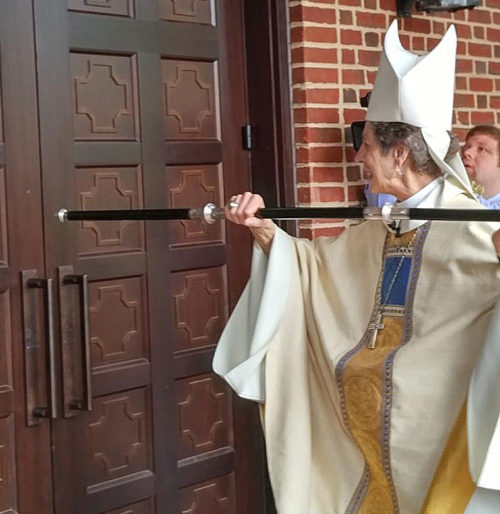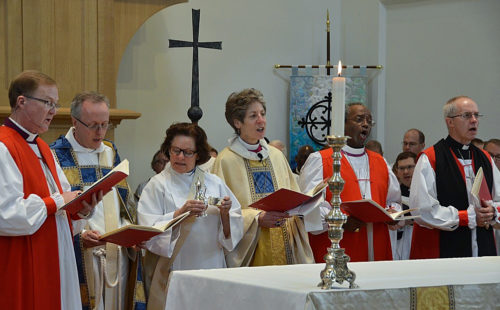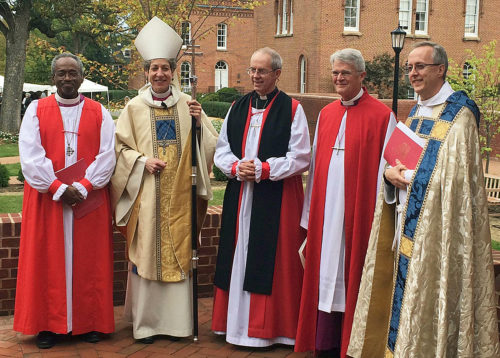Virginia Theological Seminary celebrates a chapel raised from ashesDaylong festivities of dedication, consecration point to the futurePosted Oct 14, 2015 |
|

Virginia Theological Seminary’s new Immanuel Chapel, dedicated and consecrated Oct. 13, stands beyond the ruins of the 1881 building that was destroyed in a fire Oct. 22, 2010. The ruins are now a memorial garden. Photo: Peter Aaron Otto/Robert A.M. Stern Architects
[Episcopal News Service] With three knocks on the door from Presiding Bishop Katharine Jefferts Schori, Virginia Theological Seminary began a year-long celebration its new Immanuel Chapel Oct. 13, just short of five years after its predecessor was destroyed by fire.
“In 2010 to the glory of God this chapel burned and was rebuilt 2015,” Archbishop of Canterbury Justin Welby said, beginning his sermon by paraphrasing a sign in Coventry Cathedral in England, which burned in 1940 and was rebuilt in 1962. “Is it possible? Can such an event ever be seen to glory of God? Why yes, because in death and resurrection we are drawn back into the presence of the living God who raised Jesus Christ from the dead.”

Presiding Bishop Katharine Jefferts Schori knocks three times on the door to Virginia Theological Seminary’s new Immanuel Chapel at the beginning of the building’s dedication and consecration Oct. 13. Photo: Virginia Theological Seminary
Jefferts Schori stood outside the chapel and used her pastoral staff to knock three times on the chapel door and declared, “Let the doors be opened.” She then marked a sign of the cross on the threshold with the staff. “Peace be to this house and to all who enter here,” she said.
Following the order in the Book of Common Prayer, the episcopal participants blessed in turn the baptismal font (retired Diocese of Utah Bishop Carolyn Tanner Irish, honorary co-chair of the capital campaign for the chapel), the processional cross and torches (retired Diocese of Easton Bishop James Shand, VTS board of trustees chair), the organ (Presiding Bishop-elect Michael Curry) and the ambo/pulpit (25th Presiding Bishop Frank Griswold, co-chair of the capital campaign for the chapel).
Jefferts Schori blessed the altar prior to it being vested and set for the Great Thanksgiving. Virginia Bishop Shannon Johnston blessed the ambry after communion.
The sequence hymn, written for the service by the Rev. Carl P. Daw Jr. as a gift from the Class of 2015, included the request that God “build us a faithful household set upon a holy hill.” The seminary commissioned its professor of church music, the Rev. William Bradley Roberts, to write “A Festal Gloria,” which was sung after the altar was vested and set, and before the peace.
All of it was in celebration of the new chapel building. Welby warned during his sermon that church buildings can be both blessings and burdens: “Sometimes they are the servants of the church,” he said, and sometimes they are the church’s tyrant with their “demands and instructions.”
Church buildings are only brick and mortar but, buildings such as the new Immanuel Chapel’s “astonishing and wonderful and beautiful space” welcome pilgrims and give them a sense of “exultation and beauty.”
People drawn together to worship come with untidy hearts filled with joy, sorrow, worry, undiscerned callings and shame of sin, and emerge transformed and reoriented towards service, he said. “Holiness is not neat and clean, abiding by rules,” he said. “It is fire and flame, consuming the dark and the dirt. It is beauty and fear, causing us to fall on our faces, appalled by our sin, drawn by its radiant light and healing heat. But holiness is never tidy.”
And, while worship can transform and reorient participants, it should never seek to make people conformists, he said. “Let this never be a place that seeks to tidy people up,” Welby said.
The archbishop called for the chapel to “orientate and shape those who will carry the torch of unity.” Saying his heart breaks when he contemplates the divisions in the world, Welby prayed, “O God, we needed a united church.”
Welby also cited the Anglican Communion’s divisions, “in which I am personally, deeply implicated.” He called on the congregation to “recognize, contemplate and mourn” the fact that “we too turn from God and lose sight of God’s mission.”
The church must be built on the rock of obedience to Jesus’ word, the archbishop said.
“There is no compromise with that message. Without it, this is a museum, an interesting social anthropology,” he said. “With Jesus as its focus and center, it is a channel of the breaking in of the kingdom of God. For Immanuel Chapel to live up to the beauty of its architecture it must a place not of tidiness or conformity but of transformation and daily conversion, as St. Benedict would have it. It is to be a place where the encounter with God turns a traveling crowd of pilgrims into the people who meet God in Christ.”
And, having met God in Christ, the pilgrims who come in as sinners, Welby said, “find forgiveness and go out with new heart and hope to transform a world in which otherwise darkness seems to extinguish light, fear surrounds and despair-filled suffering encompasses the weakest and the poorest.”
The text of Welby’s sermon is here.

Diocese of Virginia Bishop Shannon Johnston, Virginia Theological Seminary Dean Ian Markham, Deacon Susan Ackley Lukens, Presiding Bishop Katharine Jefferts Schori, Presiding Bishop-Elect Michael Curry and Archbishop of Canterbury Justin Welby sing Oct. 13 at the altar in Immanuel Chapel during the building’s dedication and consecration Eucharist. Photo: Richard Schori
The service’s offertory was dedicated to the effort to rebuild the Episcopal Diocese of Haiti’s Holy Trinity Cathedral in Port-au-Prince, which was destroyed by an earthquake in January 2010.
“As a community we are very conscious that our loss coincided with the earthquake in Haiti that destroyed the cathedral,” said the Very Rev. Ian S. Markham, dean and president of VTS, in his welcome. “As we celebrate, we want to do our part in bringing close to the moment that our sisters and brothers in Haiti will celebrate in their new cathedral.”
“This seminary is determined to continue to serve The Episcopal Church and the wider Anglican Communion through this chapel,” Markham said. “We take to heart what we heard from the archbishop of Canterbury. We still strive to seek to serve God and, in all things, to God be the glory.”
The post-communion hymn, “Great is Thy Faithfulness,” echoed the day the previous chapel was destroyed. It had been sung by those whom Markham called together for prayer as the 1881 Immanuel Chapel was burning.
Later on Oct. 13, Welby officiated at a choral evensong that began with 25th Presiding Bishop Griswold standing high up in the bell tower, blessing the chapel’s new bells. A microphone malfunction required Griswold to begin the service three times. Finally blessed without benefit of a working microphone, the bells pealed as Griswold left the tower to return to the narthex for the procession.
The chapel’s tower features eight change ringing bells. Cast by Whitechapel Foundry in London, the bells were lifted into place in late 2014. Whitechapel Foundry, the oldest manufacturing company in Britain, also cast the original Liberty Bell and Big Ben, the hour bell in the clock at Westminster. In change ringing no attempt is made to produce a conventional melody; the bells are rung in a set of permutations.
Evensong also included dedication of two works of art. One, “Icon of the Incarnation”, was commissioned of Olga Shalamova. The other was a sculpture, “Mary as Prophet.” Commissioned of Margaret Adams Parker, the sculpture placed outside the chapel depicts Mary as a young teenager who carries the Eternal Word and is prompted to share the world-changing message.

Presiding Bishop-Elect Michael Curry, Presiding Bishop Katharine Jefferts Schori, Archbishop of Canterbury Justin Welby, former Presiding Bishop Frank Griswold and Virginia Theological Seminary Dean Ian Markham gather Oct. 13 before the seminary’s consecration and dedication of Immanuel Chapel. Photo: Matt Rhodes/VTS via Facebook
Following evensong, Robert A.M. Stern, founder and senior partner of the New York architectural firm that designed chapel, addressed the congregation. Stern said he was grateful to be able to contribute to the seminary’s mission. “The design of a sacred space is one of the great privileges that an architect could wish for,” he said.
After thanking his staff, colleagues and the actual builders, Stern also thanked the seminary community and its vision “Architects are only as good as their clients let them be,” he said, to some laughter and applause.
In introducing Stern, Markham said the school wanted a building that looked like it had always been a part of the existing “village of buildings” on campus and also one that offered new possibilities for worship.
“As you look around the new Immanuel Chapel I hope you will judge that we have found our way, that we have found something fresh to say amidst our troubled present,” Stern said. “And as we move into the unknowable future I hope our intent to build for the ages will be rewarded.”
The architect said rather than be simply replicate the 1881 building, or design one that was only innovative, his firm wanted to embrace the seminary’s past as well as its vision for the future. “We did not set out to build a 19th century church,” he said.
The firm, whose clients range from universities to Disneyland and the New York theater district, designed a building with the flexibility to accomplish the seminary’s mission to teach future clergy to lead worship while serving “as an understated backdrop to a range of liturgical purposes from large-scale celebrations to intimate services.” The seminary’s chapel also has been home to the parish now known as Immanuel Church-on-the-Hill since the mid-19th century.
The day’s celebrations kicked off a “dedicatory year” of events at the seminary to celebrate the new chapel.

The Oct. 22, 2010, fire that destroyed the 1881 chapel building at Virginia Theological Seminary was ruled accidental by the U.S. Bureau of Alcohol, Tobacco, Firearms and Explosives. Photo: U.S. Bureau of Alcohol, Tobacco, Firearms and Explosives and the Alexandria Fire Department.
The U.S. Bureau of Alcohol, Tobacco, Firearms and Explosives (ATF) investigated the 2010 fire and ruled six days after the blaze that it had been an accident. The federal response is routine when a fire of that size occurs in a house of worship, the seminary and the ATF said at the time. The fire began in a trashcan left near a heater in the sacristy.
The late Victorian wooden structure had no smoke detector or sprinkler system, and the fire spread quickly. Damage to the chapel, consecrated in 1881, was estimated at $2.5 million, the ATF said.
The school’s trustees agreed in November 2011 to build a new chapel to replace the one that was destroyed. The remnants of the 1881 building were preserved as a memorial garden.
Ground was broken in September 2013 and the first Eucharist was celebrated in the new chapel on Feb. 12, 2015.
The new Immanuel Chapel is part of a “Worship and Welcome” quad, which includes an improved welcome center and a new motor court, creating a new gateway from Seminary Road to the campus.
The school’s “Chapel for the Ages” capital campaign raised more than $14.3 million for the project. The campaign was chaired by Cynthia C. (Cece) Fowler, the Rev. J. Barney Hawkins IV (VTS vice president of institutional advancement) and 25th Presiding Bishop Griswold. Retired Utah Bishop Tanner Irish was honorary co-chair.
The order of service for the dedication and consecration Eucharist is here.
The order of service for evensong is here.
Both services were live streamed. The Eucharist is available for viewing here. Evensong is available for viewing here.
– The Rev. Mary Frances Schjonberg is an editor/reporter for the Episcopal News Service.

Social Menu